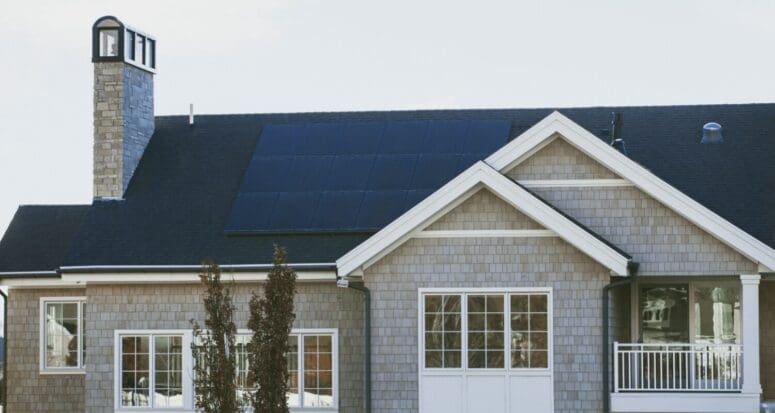Will Going Green Save You Green? The ROI Eco Friendly Homes
- Published on
- 2 min read
-
 Jaymi Naciri Contributing AuthorClose
Jaymi Naciri Contributing AuthorClose Jaymi Naciri Contributing Author
Jaymi Naciri Contributing AuthorJaymi Naciri is a Dallas, TX-based mom of two humans and three dogs who has combined her two obsessions—writing and shelter—into a career spanning three decades. Her work can be seen in Realtor, Realty Times, and LendingTree, to name a few.
Green living has been trending for many years, as homebuyers seek properties with a lower carbon footprint and renovate with energy-efficiency in mind.
In fact, sustainable living—ranging from food to travel—dominated the Pinterest 100 for 2019, an annual list of hot trends.
Those looking to buy a green home or add eco-friendly features to their existing home may have the environment and decreased utility bills in mind. But where do these homes and features lie on the return on investment (ROI) scale?
We’re taking a look at how they perform when it comes to providing real value to homeowners. Here’s what you need to know about the ROI on eco-friendly homes:

Buying an eco-friendly home
Looking to buy an eco-friendly home and concerned that you may have to pay more? There’s a perception that green homes command a premium, but this may not always be true.
A recent Realtor.com analysis of the top 200 metro areas in the country shows that prices for homes with eco-features such as solar panels, smart thermostats, and bamboo floors vary depending on the specific location.
For example: in Dallas, homes with eco-features were priced 4% higher than the median home price but essentially the same price as the median-priced home in Fort Collins, CO. Meanwhile, homes with green features were actually priced 5% lower than non-green homes in California’s Silicon Valley area of Sunnyvale/San Jose/Santa Clara.
If you are considering paying a bit more now for the eco-features you want, consider that the growing popularity of eco-friendliness may continue to push your ROI on resale.
Millennials comprise the largest share of homebuyers today, according to the National Association of REALTORS® 2019 Home Buyers and Seller Generational Trends Report, and this group is increasingly enamored with living green.
In fact, a survey conducted by The Guardian newspaper found this to be a worldwide phenomenon.
“More than two-thirds of millennials ‘buy as many eco-friendly products as they can’ and in a recent survey of 66% of global respondents say that they’re willing to pay more for products and services which come from companies that are committed to a positive social and environmental impact,” they said.
Renovating a home
Renovations like changing light bulbs to LEDs and adding a programmable thermostat are easy and inexpensive, and can make a difference in your energy output as well as ongoing utility costs.
Here are a few other popular green renovations:
Tankless water heater
Water heating is responsible for 16% of the typical home’s energy costs. Changing out an old, inefficient water heater for a tankless version could cost a couple thousand dollars, but will save money every month and could also boost your ROI when you decide to sell your home.
New windows
The same could be said about energy-efficient windows. The Department of Energy says heat gain and loss through older windows is responsible for 25–30% of energy usage for heating and cooling.
According to Consumer Reports, Energy Star-certified windows can lower your home’s energy bills by up to 15%.
Solar panels
The conversation around solar panels often begins with, “How much money can I save?” and quickly turns to, “How much will it cost to get started?”
One of the drawbacks to installing solar panels in an existing home or including them when building a home is the upfront cost.
Falling costs—especially in comparison to the rising costs of domestic electricity—have led to soaring demand; according to the U.S. Department of Energy, “The amount of solar power installed in the U.S. has increased more than 23 times over the past eight years.”
- They can add value to your home: The good news is that homes with solar energy systems have proven to raise a home’s value. One study found that homebuyers were willing to pay a premium of $15,000, and, according to the U.S. Department of Energy, homes that feature solar panels may also sell faster than homes that derive their energy from fossil fuels.
- A caveat: That said, determining the ROI of installing solar yields a rather complicated equation. According to Energy Informative, a five-kilowatt system—the average size of a system in the United States—can cost around $20,000. But the exact size of the system you’ll need will be determined by the size of your residence and how much power you use. Another consideration is the home’s location, as there may be state rebates available to you, in addition to federal tax credits. Finally, you should think about how many years you intend to stay in the home, and compare the average monthly savings of using solar with how much of the system you’ll have paid off by the time you intend to move.
Going green with your home could save you money in the long run. But it’s important to do your research and understand how long it could take to see a return on your renovation investment to determine if it’s the right decision for you.

Appraising the home
When it comes to green homes, knowing what you’re getting—or what you’re selling—is key to securing the best ROI. That means working with a real estate agent and an appraiser who are well-versed in eco-friendly features.
A recent study by Build It Green and Pacific Gas and Electric Company (PGE) found that, while green homes do fetch higher sales prices, their features are often undervalued by real estate agents and listing services.
“While countless homes have extensive green features, relatively few are properly documented, scored, or certified, and green home features are often not listed on the Multiple Listing Service (MLS),” stated the report. “This study adds to mounting evidence across the country that green-certified homes have greater value at time of sale.”
“We already know that consumers prefer greener homes because they save money, conserve resources, and provide greater comfort and health benefits,” says Karin Burns, Executive Director of the nonprofit Build It Green, which commissioned the study.
“Now we can add one more benefit to that list—greater resale value.”
Header Image Source: (Vivint Solar/ Unsplash)
